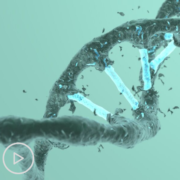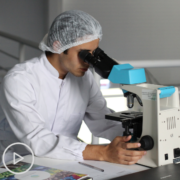Why Should AML Patients Undergo Genetic Testing?
Why Should AML Patients Undergo Genetic Testing? from Patient Empowerment Network on Vimeo.
AML expert, Dr. Pinkal Desai, explains the necessity of genetic testing when AML is diagnosed, including an overview of relevant tests and how results can affect prognosis, risk factors and treatment.
Dr. Pinkal Desai is an Assistant Professor of Medicine at Weill Cornell Medical College and Assistant Attending Physician at the New York-Presbyterian Hospital. More about this expert here.
Subscribe to stay up-to-date in the latest information in AML testing
Related Resources

|

|
Transcript:
Dr. Pinkal Desai:
So the reason that genetic testing is important and the patient should go through genetic testing after a diagnosis of AML, there are several reasons, actually, and we’ll go one by one. But before I go there, I want to clarify that genetic testing in AML does not mean that we’re testing for whether the patient inherits this mutation or genetic abnormality.
This is actually a mutation or genetic damage in the leukemia cells and not in the patient’s body elsewhere, so it’s important; this is a tumor-defining test and not meant to actually figure out whether this is inherited or not because most AML is actually not inherited. The other part that I want to focus on is that this testing, genetic testing or molecular testing or molecular profiling of leukemia, as we call it, is different than cytogenetics. Sometimes patients can be a little bit confused between what is molecular profiling and what is cytogenetics. Cytogenetics are big DNA or big changes in the chromosomes, while molecular mutations are single point gene mutations, which requires a much more detailed analysis of the leukemia cells.
The reasons that this testing is important, and the other part of it is that it’s just not after; it’s actually during the whole process of diagnosis of AML. If AML is suspected, then it should be done on the diagnosis bone marrow at the time when we’re drawing the blood. Otherwise, many times patients have to repeat a bone marrow biopsy to get this testing. So if something is already suspected that we are gonna maybe find leukemia, this should be done at the time of diagnosis. The first reason, which is the most important, is that when we do this molecular testing there’s a set of genes that we test. It’s 200s, 300s; every panel is a little bit different, but generally have the best components that we care about in the AML diagnosis.
There are targeted treatments against some of these mutations, and it’s important to know these mutations before the treatment begins. Not all mutations will change the way the treatment is designed, but there are certain mutations like FLT3, IDH, where it might matter as to what you choose as the frontline or the first line treatment, so it’s important that we actually get these results, at least some of these results, by the time we decide to choose the right treatment for the patient.
The second reason this is relevant is when patients go through AML induction or the first line treatment, the goal of which is induce remission, once they are in remission, the work is not done. There are several other things that we have to do and more treatments that are designed based on this molecular testing.
For example, depending on the molecular testing and the cytogenetics or the chromosomes, we profile patients as low risk, intermediate risk, or high risk. This risk means what is the likelihood that this leukemia will come back in the future, and how would that impact the patient’s survival? Some of the post-remission treatments are designed to change depending on the results of these mutations, so it’s important to actually know this at diagnosis because then the patients would go into remission, and yet we have to make a decision on what kind of best treatment to give post-remission in order to make sure that the patient is cured, or we maximize the chance of cure in this patient.
So the kind of chemotherapy, whether to transplant or not transplant, all of this is dependent on the molecular mutations. The third reason, which is becoming more and more relevant now in AML, is some of these mutations can be monitored over time.
It’s a much detailed testing to know the kind of remission or the extent of remission that they patient achieves, and you can actually follow these mutations over time, even in remission, to know that – is the molecular mutation zero, is it 0.2%? This is a very upcoming field in AML, and the idea of monitoring these mutations is relevant because if you have a mutation, can you do something about it post-remission? Would that alter some of the treatments? Would that help us anticipate if a relapse is coming before the actual clinical relapse happens and the blood counts go abnormal? Can we anticipate is this patient likely to relapse, for example, six months later, and could you prevent these relapses?
These are all the reasons why these genetic testing or molecular profiling of leukemia is highly relevant in the field of leukemia. We all cannot even make a decision anymore without having this full panel.






